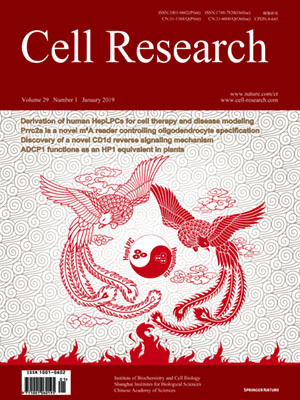
Volume 29, No 1, Jan 2019
ISSN: 1001-0602
EISSN: 1748-7838 2018
impact factor 17.848*
(Clarivate Analytics, 2019)
Volume 29 Issue 1, January 2019: 42-53
ORIGINAL ARTICLES
Glycolipid iGb3 feedback amplifies innate immune responses via CD1d reverse signaling
Xingguang Liu 1, Peng Zhang 1,2, Yunkai Zhang 1, Zheng Wang 3, Sheng Xu 1, Yingke Li 1, Wanwan Huai 4, Qingqing Zhou 1, Xiang Chen 1, Xi Chen 4, Nan Li 1, Peng Wang 5, Yunsen Li 3 and Xuetao Cao 1,4,6,7
1National Key Laboratory of Medical Immunology & Institute of Immunology, Second Military Medical University, Shanghai 200433, China; 2Department of Haematology, General Hospital of Southern Theater Command, Guangzhou 510000, China; 3Laboratory of Cellular and Molecular Tumor Immunology, Institutes of Biology and Medical Sciences,Jiangsu Laboratory of Infection Immunity, Soochow University, Suzhou 215123, China; 4Institute of Immunology, Zhejiang University School of Medicine, Hangzhou 310058,China; 5College of Pharmacy, Nankai University, Tianjin 30071, China; 6College of Life Science, Nankai University, Tianjin 30071, China and 7Department of Immunology & Center for Immunotherapy, Institute of Basic Medical Sciences, Peking Union Medical College, Chinese Academy of Medical Sciences, Beijing 100005, China
Correspondence: Xuetao Cao (caoxt@immunol.org) or Xingguang Liu (liuxg@immunol.org)These authors contributed equally: Xingguang Liu, Peng Zhang, Yunkai Zhang
The cross-talk between cellular lipid metabolism and the innate immune responses remains obscure. In addition to presenting lipid antigens to Natural Killer T-cells (NKT cells), the Cluster of Differentiation 1D Glycoprotein (CD1d) might mediate reverse signaling in antigen-presenting cells (APCs). Here we found CD1d deficiency attenuated Toll-like receptor (TLR)-triggered inflammatory innate responses in macrophages and dendritic cells, protecting mice from endotoxin shock. TLR activation in macrophages induced metabolic changes of glycosphingolipids (GSLs), among which glycolipid isoglobotrihexosylceramide (iGb3) was rapidly produced. The endogenously generated iGb3 bound CD1d in endosomal compartments and then synergized with the initially activated TLR signal to induce Tyr332 phosphorylation of CD1d intracellular domain. This led to the recruitment and activation of proline-rich tyrosine kinase 2 (Pyk2). Pyk2 interacted with IκB kinase β (IKKβ) and TANK-binding kinase 1 (TBK1), and enhanced tyrosine phosphorylation of Tyr188/199 of IKKβ and Tyr179 of TBK1 and thus, their activation to promote full activation of TLR signaling. Thus, intracellular CD1d reverse signaling, triggered by endogenous iGb3, amplifies inflammatory innate responses in APCs. Our findings identify a non-canonical function of CD1d reverse signaling activated by lipid metabolite in the innate immune response.
https://doi.org/10.1038/s41422-018-0122-7
FULL TEXT | PDF
Browse 1269


